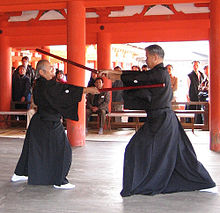Kenjutsu
kenjutsu (剣術) is a traditional Japanese martial art of koryū budō. There are several schools (ryu) whose objective is to teach how to fight efficiently with the Japanese saber. The practice can be developed in many ways depending on the ryu (school) practiced.
History
The styles of kenjutsu, as known today, took shape from the Muromachi period (15th and 16th centuries).
Among the styles of that time, the following stand out:
- Tenshin Shoden Katori Shinto Ryu, created by Iizasa Chōisai Iga-no-kami Ienao.
- Kashima Shinto Ryu, created by Tsukahara Bokuden.
- Kasumi Shinto Ryu, created by Makabe Hisamoto, disciple of Tsukahara Bokuden;
- Chûjô-ryû, created by Chujō Hyōgo-no-kami Nagahide.
- Nen-ryû, created by the monk Nen-ami Jion, in particular Maniwa Nen-ryū.
- Shinkage-ryû, created by Kami-izumi Ise-no-kami Hidetsuna from Kage-no-nagare, created by Aisu Ikōsai Hisatada.
Kenjutsu expanded greatly during the Edo period (16th to 19th centuries), registering more than 500 styles. At the end of this period, some styles began to use shinai, the bamboo sword, and bōgu, the protective armor, to bring more security to training. This training was the precursor to modern kendo.
Some of the main styles of kenjutsu that developed in the Edo period were:
- Niten Ichi Ryu, or with two sables created by the legendary Miyamoto Musashi; several schools in Japan currently play their lineage.
- Yagyu Shinkage Ryu, created by Yagyu Muneyoshi, from the Shinkage Ryu of Kami-izumi Ise-no-kami Hidetsuna. Influencing the traditional martial art of Aikido, because its founder Morihei Ueshiba practiced it.
- Ittō-ryū, created by Itō Ittōsai Kagehisa, from the Toda-ryû style, which is the legitimate lineage of the Chūjō-ryū style, created by Chujō Hyôgo-no-kami Nagahide, is the style in which the modern martial art of sable or kendo is fundamentally based.
- Suio Ryu, by Mima Yochizaemon
- Jigen Ryu, developed by the Satsuma clan, who invaded the Kingdom of Ryūkyū, now known as the Okinawa Islands. Influence especially to karate style shorin ryu. That in turn influenced the best known styles of Japanese karate; being these styles shotokan, wado ryu and Shit ryu.
With the Meiji Restoration, at the end of the XIX century, and the ban on carrying swords, various styles ended up disappearing, a fact that was repeated after the Japanese defeat in World War II (1939-1945). But there are still several that survive to this day. There are currently two organizations, the Nihon Kobudō Kyōkai and the Nihon Kobudō Shinkōkai, which bring together various styles of kenjutsu that currently exist.
Among the styles that still exist, practiced in a continuous line, we highlight Niten Ichi Ryu, Suio Ryu, Katori Shinto Ryu, Kashima Shinto Ryu, Ittō-ryū, and Kashima Shin Ryu. In most of these styles there are no colored belts to determine the level of the practitioners. Instead of degrees, licenses such as the menkyo kaiden are issued. Modern examples of gendai budō or contemporary martial arts derived from the art of the sword are: kendo and iaidō.
Practice
Kenjutsu or classical saber training varies according to the style in question. For the most part it is based on kata (or pre-established forms). In some styles, the practice of the kata is complemented by combat training using protective armor.
In training forms or kata, a wooden sword similar to the katana, called bokken or bokuto, is normally used. . Each style of kenjutsu usually imposes specific measures of length, width and curve for its bokuto.
In combat training, dōjō who do so use some form of protection to avoid serious injury. Most use the same kendo armor, called bōgu (armor made of bamboo, lacquer, cords, and cloth coverings) and shinai (bamboo sword). Another weapon that can also be used to fight is the fukuro-shinai, a sword similar to the shinai used in the modern art of saber or kendo, but with the same length as a katana y, constructed from several strips of bamboo, covered with a leather covering. Some styles use cut metal sabers (shinken) for cutting training. It should be noted that each style has its own training characteristics. The practitioner already begins with the drawn sword. In some styles, such as Niten Ichi Ryu, there are specific techniques for the use of two swords, one in each hand.
The kenjutsu is a physical, spiritual and mental discipline; For its practice, the balance between body and mind is necessary, more than physical strength and vigor. The deepest teaching of kenjutsu has a quite strong physical-religious aspect, under influences mainly from Shintoism, Confucianism and Zen Buddhism.
Several martial arts descend from or have been influenced by kenjutsu, such as: kendo, its modern version, which has a greater "sportive" emphasis; the iaidō, or the art of drawing the sword. And among modern traditional martial arts or gendai budō. aikidō incorporates principles of sword training into several of its movements. However, sword training is not emphasized, except in the Iwama Ryu style.
Kenjutsu today in Japan
Many schools of kenjutsu managed to survive the end of the samurai and reach our days, in a continuous line without interruptions.
Dojos of kenjutsu are maintained throughout the Japanese territory. Demonstrations organized by the Nihon Kobudō Kyōkai and the Nihon Kobudō Shinkokai are held annually.
Far from being a popular activity, most kenjutsu dojos have a relatively small number of practitioners. In part it is due to the martial and traditional nature of the practice and also due to the lack of interest of the new generations in preserving more traditional aspects of Japanese culture.
Contenido relacionado
Conmebol Cup
Cha Cha Cha
George Harrison
